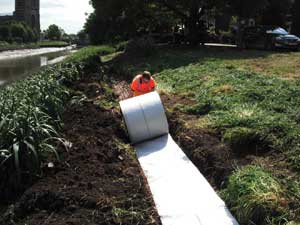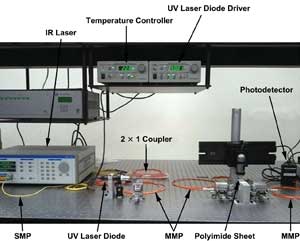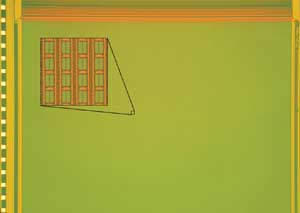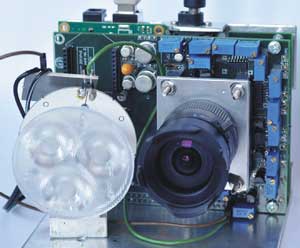Light, sturdy fiber optic sensors can help monitor conditions in power plants, on airplane wings,
on dams and in other hard-to-reach places.
The composition of fiber optic sensors enables them to be placed in areas where traditional point sensors simply cannot go. “If you can glue it, wrap it, wind it, bury it, encase it or bond it, fiber optic sensing can monitor it,” said Paul Richardson, senior product manager at Oz Optics Ltd. of Ottawa, Ontario, Canada.
Today, fiber optic sensors are cropping up in a variety of places, including turbine blades, power cables, airplane wings, dams and levees, where they can be used to measure strain, temperature, light intensity or even air pressure.
Compared with electrical sensors, fiber optic sensors are lighter in weight and can operate in extreme environments – and the lack of electrical current running through them means that they are not a spark hazard and are immune to electromagnetic interference. This expands the number of places in which this technology can be deployed to include power plants and other highly sensitive environments.
“Hazardous or explosive environments are fine for fiber optics, as there is no risk of generating a spark,” Richardson said. “Caustic environments are also acceptable, since the fibers are made of silica glass. High-EMF [electromagnetic force] areas are good candidates for fiber optic sensing, since the method of measurement is essentially immune to electromagnetic interference.
“When properly designed, they are also suitable for placement in areas of ionizing radiation. We’ve even performed measurements using fiber optics at 20 degrees Kelvin inside a cryostat.”
Thanks to decreasing instrumentation costs and the ability to make measurements over increasingly long distances of the fiber itself, these sensors are making their way into some unusual places.
One such application with which engineers at Oz Optics were tasked was to monitor the strain when firing a large gun. In this case, extreme levels of force were being used to launch each round, and the customer wanted to ensure that the weapon was safe to fire.
The solution came in the form of a specialized distributed strain and temperature sensor (DSTS) that can measure within 10 s after a wide change (5 percent) in strain and temperature, enabling the weapon to safely fire at its maximum rate.
“We made several interesting discoveries regarding noise sources, stability, wavelength locking speed, signal processing and processing of measurements,” Richardson said. “In all, it was a dramatic application that required a complete revisit to every component of the DSTS design. From that wholesale review, improvements to our normal designs were made.”
Other interesting applications on which the company has started working involve using a DSTS to detect erosion, potential mountain slides, and weaknesses in dams and levees. But the problem here is the placement of the fiber optic sensor.
“A lone fiber does not remain bonded well in earthworks over the seasons, which may result in changes to the strain or temperature being missed,” Richardson said.
The answer this time came with the help of Netherlands-based textile specialist Royal Ten Cate, which developed a geotextile material that could bond to the earth. By embedding the geotextile material with sensing fibers, the resulting GeoDetect sensor is set to be used at a tailings dam project for long-term safety assurance. Tailings dams are constructed to safely house mounds of waste material from mining sites.
Layering Ten Cate’s GeoDetect and measuring with Oz Optics’ DSTS develops a complete strain and temperature profile, Richardson explained. “This provides ample data and insight into the characteristics of the tailings dam. An accurate strain and temperature profile can now give assurances that any future defects can be detected and corrected prior to any serious risk of failure.”

Ten Cate’s GeoDetect fiber optic system is embedded with Oz Optics’ DSTS, providing distributed sensing along its entire length for long-term safety assurance of projects including tailings dams. Image courtesy of Oz Optics.
As well as being able to go where many conventional sensors cannot, fiber optic sensors have the added advantage of distributed sensing along the entire length of the fiber. So, instead of conventional point sensing, where measurements are made only at discrete points in a system, distributed sensing provides a much greater assurance of measuring perturbations.
For instance, Oz Optics’ Brillouin systems can make measurements along the entire length of 100 km of fiber. For fiber lengths of 1 km, about 20,000 measurement points are provided, all without the need for electrical power, metal wires, multiple connection points or tedious localization of the singular point sensors.
Although Oz Optics currently advertises 100 km of sensing length, Richardson reveals that the company has gone much farther than just 100 km, for which longer sensing lengths are very important to pipeline and power-line monitoring.
The self-healing sensor
By their very nature, sensor networks often are embedded in locations or structures that are subject to dramatic amounts of stress and strain. This poses a challenge to sensor designers: The sensors must survive as long as the surrounding structure because they are typically inaccessible and therefore cannot be replaced.
Dr. Kara Peters, a professor of mechanical and aerospace engineering at North Carolina State University, saw the benefits of structural health monitoring over the past couple of decades and was motivated to develop a strain sensor that can “self-repair” if damaged, without the need for external stimuli or user access.

A new self-healing sensor was developed at North Carolina State University. SMP = single-mode patch cord; MMP = multimode patch cord. Courtesy of North Carolina State University.
The sensor contains two glass optical fibers that lie in a reservoir filled with ultraviolet-curable resin. The fibers can stretch and compress along with the material that the sensor monitors. Infrared light is delivered by one fiber to a polymer waveguide and is delivered to the other optical fiber.
“As the polymer waveguide is stretched, infrared light is lost into the surrounding resin,” Peters said. “Therefore, as the amount of elongation increases, the amount of infrared light transmitted through the waveguide reduces.”
With the sensing task handled by IR light, the job of self-healing is performed using UV light, which is transmitted along one of the fibers. When the beam hits the resin, it hardens, creating a thin polymer filament that connects the glass fibers – a closed circuit for the IR light. The rest of the resin in the reservoir remains in liquid form, surrounding the filament.

A self-healing fiber optic sensor: (a) the polymer filament connecting the glass fibers in the sensor; (b) the filament has snapped off; (c) the resin has rushed into the gap, been exposed to UV light and reconnected the filament – effectively repairing itself. Images courtesy of North Carolina State University.
The remaining liquid resin is important. If the polymer filament breaks under stress, more liquid resin rushes into the gap, comes into contact with the UV beam and hardens – repairing the sensor automatically.
Events that can break a sensor, but that don’t break the structure being monitored, are important. Peters envisions applications where the sensor would be embedded into structures that are inaccessible for replacement or repair, such as in an aircraft airframe, wind turbine blade or buildings.
“For each of these applications, one would need to know how the performance of the structure degrades with time. For the airframe example, the structural degradation could be due to fatigue, lightning strikes, bird strikes, etcetera,” she said. “This condition-based monitoring can lead to reduced maintenance times and increased safety for aircraft and civil infrastructure systems.”
The self-repairing polymer waveguide sensor was described in a paper published in June in Smart Materials and Structures. Peters notes that, as with any sensor system, further testing of the durability, long-term performance and performance in different environmental conditions is needed – a process that could take a few years.
The sensor was created thanks to a combination of many technological advances including recent advances in self-writing waveguides and concepts from self-healing materials in materials science. Peters believes that these technologies will deliver sensors with capabilities beyond those demonstrated by conventional optical fibers.
Smart sensors
Smart sensors already are demonstrating new capabilities. They are solid-state devices typically fabricated using CMOS technologies. They can measure a physical quantity (for example, light intensity, temperature, humidity and pressure of the air) and process the result with a certain amount of “intelligence.”

Smart sensors in development at Fondazione Bruno Kessler include this CMOS range-image sensor chip, seen in micrograph with a magnified view of the pixel structure in the inset. Courtesy of Fondazione Bruno Kessler.
“The extra functionality is achieved thanks to the use of the CMOS technology, which enables the implementation of sophisticated processing functions such as embedded analog-to-digital conversion, calibration or communication interfaces between the smart sensor and a network,” said David Stoppa, a researcher in the Smart Optical Sensors and Interfaces department at Fondazione Bruno Kessler, a research organization in Trentino, Italy.
Some of the focus of Stoppa’s current research is on next-generation image sensors such as lock-in pixels for time-of-flight 3-D imagers. A time-of-flight 3-D camera system consists of a modulated illumination module (laser or LED), an optical diffuser to obtain a flood illumination of the scene, an objective to collect the light echo and a phase-sensitive photodetector array.

Smart-sensors research at Fondazione Bruno Kessler has resulted in this time-of-flight range camera system prototype. Courtesy of Fondazione Bruno Kessler.
“This image sensor is able to provide both the conventional 2-D information (intensity map) and the depth map of objects in the scene, opening the way to thousands of new applications in virtual reality, gaming, security, cultural heritage, ambient assisted living, etcetera,” Stoppa said.
In this research field, the open challenges are to extend the sensor dynamic range, to improve immunity to background light so that outdoor operation becomes possible, to achieve higher modulation frequencies that improve the distance measurement precision and to further shrink the pixel dimension.